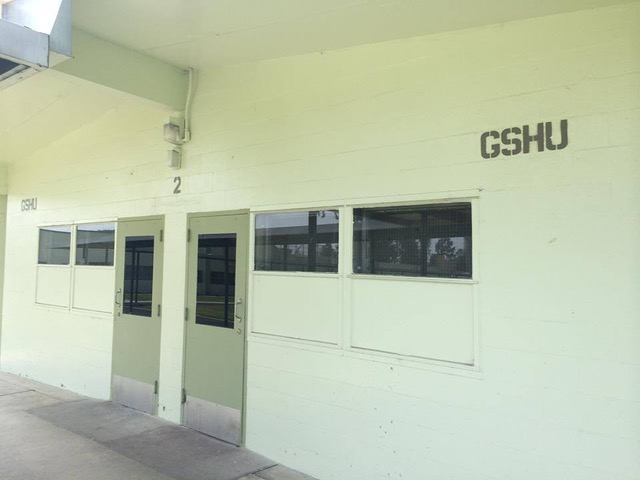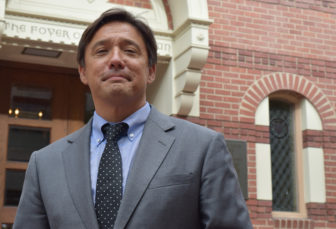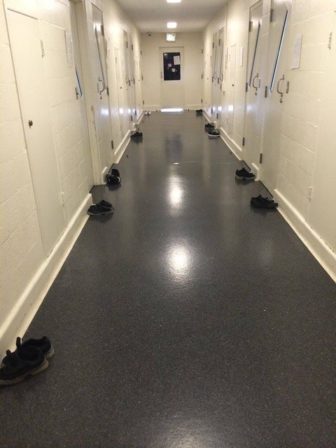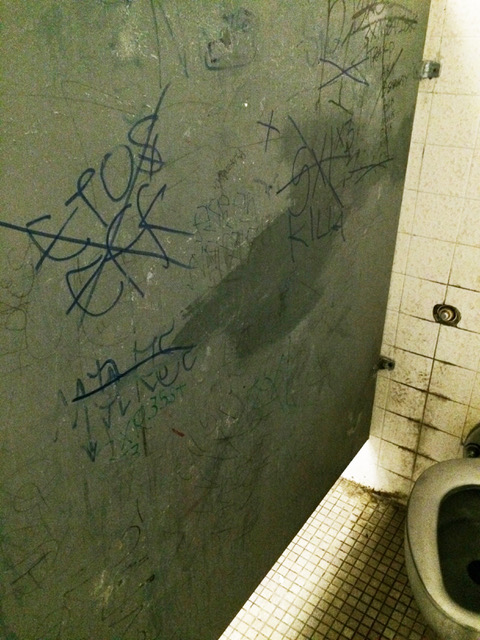
WitnessLA
A shot of solitary at Las Padrinos Juvenile Hall.
LOS ANGELES — Los Angeles County’s newly chosen chief probation officer and her new second in command, who will both take over in January, are entering LA’s troubled probation department at a pivotal moment.

Terri McDonald
For the top position, LA’s Board of Supervisors selected former Assistant LA County Sheriff Terri McDonald who until recently was in charge of LA’s massive jail system. She had been brought in to put in place reform recommendations following a series of public scandals.
To head the juvenile side of the department, the supervisors hired Sheila Mitchell, former chief of the Santa Clara (California) Probation Department, where she earned a national reputation for instituting innovative youth programs in the agency she ran for nearly 10 years.

Sheila Mitchell
Child advocates and community activists hope the new leadership duo will change what has been described as a punishment-centered culture into one that focuses on rehabilitation, treatment and the effective transition of probationers back to their communities, particularly for the kids under the county’s supervision. Thus many were cautiously optimistic last week about the choice of Mitchell given her extensive background in juvenile probation reform.
And the decision to hire two people in and of itself fostered more hope.

Peter Eliasberg
“Probation has two important and quite different functions in the populations it supervises,” said Peter Eliasberg, chief counsel of the American Civil Liberties Union of Southern California. “We think it’s important that the department move away from a law enforcement type of supervision on both of those sides. But juveniles are quite different than adults,” he continued, “and it appears that the problems of youth probation are as significant if not more significant than on the adult side. Therefore we are pleased the board did not take a one-size-fits-all approach.”
‘Deplorable’ conditions
LA County Probation, the largest of its kind in the nation, has been hit by a stream of problems in the past decade, many of them related to how the department deals with the youth in its care. Things got bad enough to bring Department of Justice monitors into the county’s juvenile halls and camps from 2004 to 2015. In 2010 a large class-action suit was filed “due to the failure” of probation “to provide adequate education to youth in the camps,” even “locking students in solitary confinement for weeks or months without attending school.” In the past few years, however, probation executives claimed that the bad old days were all but over when the DOJ signed off in April 2015.
 But more recently, a string of new red flags suggested that, despite some improvements, there is much work to be done.
But more recently, a string of new red flags suggested that, despite some improvements, there is much work to be done.
Among the issues that critics say demonstrated all was not well are recent allegations of kids being assaulted by staff inside two juvenile halls, evidence of fiscal mismanagement both on the adult and the juvenile side of probation and an April 2015 report by the LA County Auditor-Controller’s office that showed the youth detention programs weren’t doing anywhere near as swimmingly as everyone was claiming. The report came a month after a 155-page Los Angeles County Juvenile Probation Outcomes Study that showed that a discouraging percentage of the youth who were in the department’s facilities or on home probation were not getting the help they needed, and recidivating in alarming numbers.
But none of these events pushed LA County’s juvenile probation into the national spotlight. Instead, it was the release of an in-house report that detailed what the author described as “deplorable” conditions in the main juvenile hall.

Sal Martinez
LA County Probation Commissioner Azael “Sal” Martinez compiled the report in February 2015, mainly for his fellow commissioners, members of the LA County Board of Supervisors and probation department higher-ups. But in March the report was leaked to a couple of members of the press — namely WitnessLA and the Los Angeles Times, both of which wrote stories about it.
Martinez’s report was unusually frank, comparing Central Juvenile Hall to a “Third World country prison” and describing units lacking in running water and inmates kept in isolation without an apparent cause. Walls and other surfaces were reported to be covered in gang graffiti, and some urinals were said to be overflowing. Martinez noted an appalling stench due to an unrepaired sewage system. Doors to probationers’ rooms were allegedly propped open to air out the smell, not with doorstops, but their personal items.
He wrote the report after making an unscheduled visit to the facility early last year and being appalled by what he saw. After the initial two news articles, other media outlets wrote about it. People spoke out online and on social media. One LA Times online commenter wrote that he was housed in the facility 32 years ago and recalled similar awful conditions and mistreatment. Others argued that conditions were fair punishment for those who had committed crimes. Most merely expressed disgust.
The 15 probation commissioners are required to check the Probation Department’s juvenile facilities periodically and report back on their findings. When a commissioner reports a problem, the department is required to respond within 30 days.
The Probation Department was quick to investigate Martinez’s observations and allegations and act to correct the issues he listed. Some of the problems had reportedly already been hurriedly fixed by the time Probation’s inspector arrived. Other alleged violations, such as the stench from toilets,were not found during investigations, according to probation officials. Due to Martinez’s high-profile report, a significant amount of graffiti was reportedly washed away, walls repainted, bathrooms scrubbed and restored, and real doorstops bought.
The story raised significant concern. But while officials expressed their disappointment with the conditions and acknowledged the importance of fixing the issues Martinez reported, some viewed the report as a symptom of larger problems in a system that desperately needs significant reform.

Rachel Cohrs
Cyn Yamashiro
“In the scheme of all the other stuff that’s going on with the department,” said Cyn Yamashiro, another probation commissioner, “the fact that there’s some graffiti on the wall and the urinals stink … Yeah, that’s bad, but there’s a lot of other stuff that’s going on.” (Yamashiro said he spoke on his own behalf and not on behalf of the commission.)
The physical condition of the facilities does hold symbolic importance in the rehabilitative process, especially for minors, he said. He is concerned that, even though these specific instances were reportedly resolved, they were allowed to occur in the first place. He also worries about similar conditions that might be occurring unreported elsewhere in the juvenile system, he said.
“I’m not a psychologist, but I would assume that there’s a relationship between the conditions of confinement and how youth see themselves,” Yamashiro said, “and [how they] see the institution that is trying to rehabilitate them.” The physical state of the department’s three juvenile halls and 12 juvenile camps can easily be viewed “as an expression of the institution’s desire to kind of create environments that are healthy for kids,” he explained. “If kids see that the institution doesn’t care enough to fix the plumbing and fix urinals and things like that, it doesn’t say a lot about the institution’s desire to help them.”
‘We are proud of what we do’
Kerri Webb, Probation Department spokeswoman, and Scott Sanders, consultant for the department’s juvenile detention services, have a more upbeat take on the problems. Central Juvenile Hall, the largest of the county’s three juvenile halls, currently houses somewhere around 200 youth, said Sanders, noting it has a swimming pool, recreation stations, a school and two medical units.
“A lot of [the] time these kids are receiving services and educational opportunities that they didn’t take advantage of when they were on the outside committing the crime,” Webb said. “Now they are in a facility and in a program and environment where they have to go to school, and there are educational programs where they will receive the credit towards graduation. There are health professionals who will evaluate them to see what their psychiatric needs are, what their mental health needs are. We’re really proud of the fact that a lot of the times these kids, once they complete their stay here, are armed with better opportunities and better services, and more prepared to be a better juvenile in society.”

WitnessLA
A hallway with multiple solitary rooms in one of LA County’s juvenile facilities.
Educational services and a swimming pool may play a positive role in rehabilitation, according to Yamashiro and others, but that doesn’t prevent the negative factors in the juvenile halls and camps from playing a harmful one.
“At some point, the conditions themselves become the punishment,” Yamashiro said. “The farther away the environment is that they’re confined in, the farther away that is from their own home life, is I think the extent to which it is a punishment.”
And according to Yamashiro and department officials, punishment is not supposed to be the point, at least in theory.
“The goal at this point when you’re working with youth,” Yamashiro said “particularly when such a high percentage of youth come into the system with mental health disorders, diagnoses of learning disabilities” and more is that this is “not [supposed to be] an exercise in punishment. It’s really about rehabilitating kids.”
That is why it is so essential to understand how the physical conditions of the county’s various juvenile facilities can have a great deal to do with a kid’s experience when he or she is in the county’s care, he said.
“If [the facility is] an environment that allows people to be comfortable and be in a position where they can learn, they can reflect on their own behavior and how they’re going to get better,” Yamashiro said. “[If] it’s so gross they can’t do that, then it kind of defeats the purpose of them being there.”
The Probation Department agreed, but said their quick response to the Martinez report’s allegations was less publicized than the high-profile news that resulted from the report itself.
“It doesn’t get out there, but we are proud of what we do,” Sanders said. “I stand on this, that our staff cares about these kids, that the department cares about these kids. And we are trying to do everything we can to provide the services that these kids need.
“I think the public misses the piece that a lot of these kids come in broken,” Sanders said. “They come in and our job is to try to stabilize them in the length of time we have. In Juvenile Hall, the average stay is 17 days. You might have some that are there longer. You have a lot that are there shorter. So our job is to try to help them leave as fast as possible, which is not a small task.”
Webb agreed.
“That’s our goal, that’s our mission,” she said, “to rehabilitate and get them back into their community and [to] be functional members of society. We’re really proud of that. [But] that doesn’t seem to really get across to the public. We’re not about just locking these kids up. They leave many times better than they were when they came in.”
Yet critics say these worthy intentions still beg the question as to how these practices were allowed to occur in the first place, particularly those with such a simple fix as rinsing the graffiti off the wall. What prevented this disrepair from being fixed the moment it was observed, not by a commissioner, but by a Detention Service Officer or other employee who works in the facilities every day?
Fiscal mismanagement and oversight
In the past, the department has been criticized for various kinds of financial negligence. The audit released in January said the department did not adequately track its expenditures. Money was spent on employee phones that no one was using and on phones for former employees, for example. The report also found $161 million in state funds designated for much-needed adult and juvenile programs that had never been spent. Why? This was unclear. And though this sum was comprised of funding designated for programming and not facility upkeep, it suggested a level of financial dysfunction that had the potential to bleed into all areas of the department.
The cost of keeping a young person locked up in the county is unusually high, for example, compared with other California counties with large juvenile systems, according to an audit completed in April 2015.
The Average Daily Cost Per Youth or (ADCPY) for the county’s juvenile halls is $640 per youth per day in the halls and $552 in the camps. San Diego County spends $351 and $206 for camps and halls, respectively. Orange County spends $497 and $284. Harris County, Texas, $232 and $272.

WitnessLA
.
At the same time, the number of youth arrested and housed in the juvenile camps and halls is steadily declining. In 2005, the county reported 17,648 felony arrests of juveniles; that was 6,906 by 2015, according to the California Attorney General’s Office.
Fewer arrests means fewer youths in residential facilities. In early 2016, 535 youths were held in facilities designed for 1,469. Despite this low number, the department continued to pay for services for a capacity of nearly 1,000, even though the camps and halls were reportedly seriously understaffed at the time of the audit.
Yamashiro said that, like the graffiti, the fiscal issues pointed beyond themselves to larger management troubles and attitudes. “You have a department whose budget hasn’t really shrunken, but you’ve got a population of kids that’s far lower than it has been in any memory,” he said. “So there’s a lot fewer kids and the same [departmental issues] persist. And I think that’s a problem.”
So why is the cost per kid so high in LA County’s juvenile halls and camps? And what are the county’s kids getting for the money? The county auditors noted that they were not 100 percent sure about the details of how the money was being spent because, they wrote, “Probation does not adequately track expenditures for juvenile halls and camps.”
Policy change on juvenile solitary
One more issue addressed in Martinez’ original report is juvenile solitary. He wrote about a boy who was reportedly sent into isolation for 16 hours after trading his beverage carton for another inmate’s. While trading food is not allowed, Martinez noted that the punishment was a misuse of solitary confinement, which can only be used as a disciplinary action for no more than a few hours at a time. Exceptions are made for serious and rare situations.
The use of solitary confinement as a disciplinary action for juveniles has been a source of national controversy for some time, with many calling the strategy unproductive, cruel and capable of triggering permanent psychological consequences, especially with youth.
Last May, the county’s board of supervisors banned the use of solitary confinement, except in exceptional circumstances, in all the county’s juvenile detention facilities. While youth might still occasionally be separated for a cool-down period when all other options fail, the conditions of this separation were radically redefined and are supposed to now provide a more therapeutic and calming experience.
The day before these changes were approved in Los Angeles County, President Obama announced a solitary confinement ban for juveniles in federal prisons.
“Everyone agrees [solitary is] just not an appropriate way to handle crisis for youth for any lengthy period of time,” Yamashiro said.
Six months after the board of supervisors ordered solitary to be replaced with brief time-outs in a therapeutic environment, what are the results? Are staffers making use of the therapy-oriented procedures, like the newly created Hope Centers in the halls and camps? Some probation sources say that many staff feel a vital tool has been taken away from them, and are unsure what to use in its place, so often use extended periods of room confinement as a replacement. This is not what the board of supervisors had in mind.
Even more pressing than the need for a progress report on the isolation issue is the matter of the growing number of reports of alleged assaults of youth by staff in the department’s halls and camps. Video surveillance caught the beating of an unresisting boy by staff members earlier this year. The instance does not appear to be isolated. Another alleged incident surfaced the next month, and a third in October, with more rumored still to come. A report officials compiled this summer at the request of the probation commission found that monthly use of force incidents in the county’s three juvenile halls had increased 85 percent from January to July of 2015.
The two new chiefs will face a long list of key decisions and daunting challenges when they arrive in January, especially given the agency’s need for many major and vital reforms.
Which should be the priority? “In working with the last two chiefs,” Martinez said, “there’s one thing that I learned: No matter who’s in charge, there’s still a big disconnect between the executive offices in Downey and the line offices. And that disconnect needs to be fixed if we want to reform this department.”
This story is part of a series by reporters from the USC Annenberg School of Communication and Journalism, which is the product of a collaboration between the Juvenile Justice Information Exchange and WitnessLA.